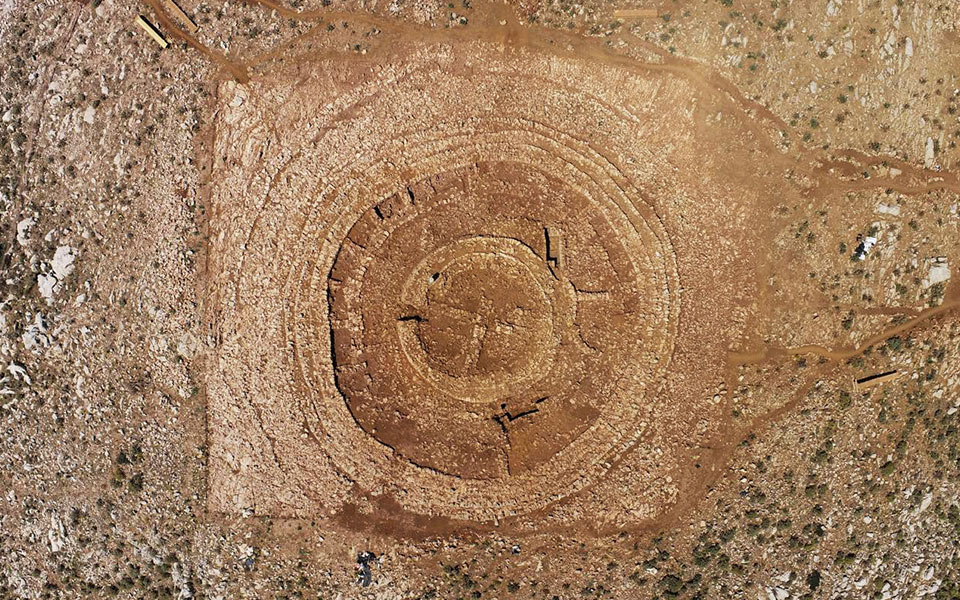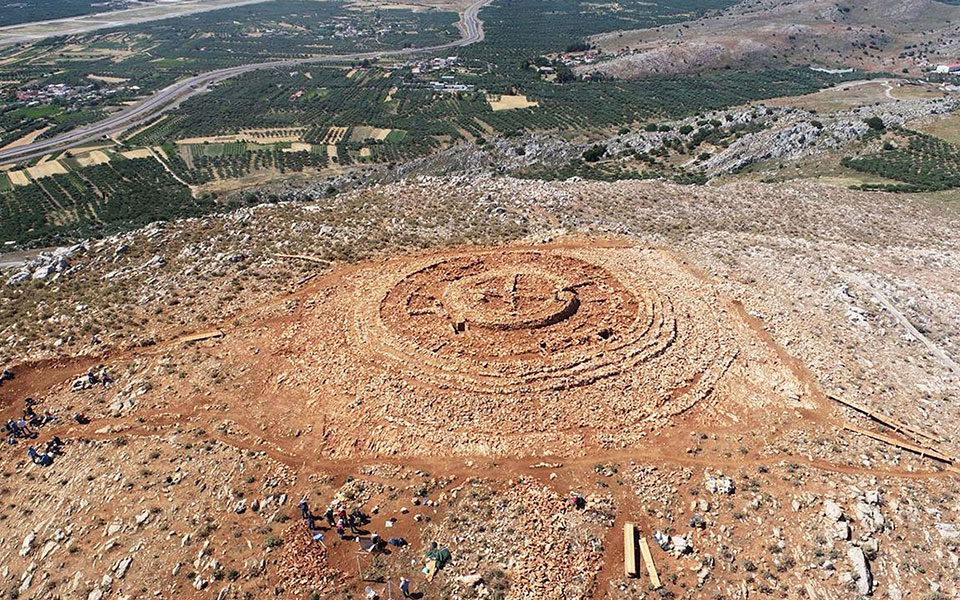A groundbreaking archaeological discovery has been made in Crete, near the under-construction international airport in Kastelli, Irakleio. A monumental circular architectural complex, believed to be from the Minoan Bronze Age (early to mid-2nd millennium BC), has been unearthed atop Papoura Hill, leaving experts both fascinated and perplexed.
The complex structure, 48m in diameter, consists of concentric stone-built rings forming an exterior stepped crepidoma (multi-level platform) and a central circular building. This central building is surrounded by radial walls, creating smaller rooms in a labyrinthine layout.
“It is definitely not a signal tower,” clarified Vasso Sythiakaki, head of the Irakleio Ephorate of Antiquities. “Nor does it relate to the worship of Zeus and Rhea, as has been written. The monument is clearly Minoan.” Despite this, the exact purpose of the structure remains unknown. Sythiakaki added, “That’s the million-dollar question. It is still too early to know. The excavation is ongoing. Whatever we say now will not be scientifically substantiated.”

© Hellenic Ministry of Culture
The monument began to be revealed five months ago during a rescue excavation led by Danae Kontopodi, an archaeologist with the Ephorate. Sythiakaki recalled, “We were all speechless; the first thing that began to appear was the stepped crepidoma, something unusual.” The discovery of the perfect circular shape and the wall of the central building forming a dome further heightened their interest. “It is something unprecedented,” she noted.
The corbel system of construction, known to the Minoans, suggests the central building may have been domed. “But this building is surrounded by circular corridors and rows of rooms,” explained Sythiakaki, “so it is definitely different. In Crete, especially on a hilltop, we have not seen such a construction before.”
Possible Ritualistic Functions
Despite the many uncertainties, archaeologists have some theories. “Our sense is that it is a gathering place where ritualistic feasts were held,” said Sythiakaki, referencing findings such as drinking and eating vessels and animal bones. The structure is believed to date to the early Protopalatial period (around 1900 BC) and was likely used into the Neopalatial period (ca. 1700-1450 BC).
While there are no similar structures in Crete, it might be compared to Bronze Age architectural complexes in the Near East. “It wouldn’t be surprising to find such parallels,” emphasized Sythiakaki. “The Minoans are known for their trade and cultural relations with Egypt and the Eastern Mediterranean coasts.”
A Unique Find
The Greek Ministry of Culture has described the discovery as a “unique find for Minoan archaeology.” The significance of the find is such that it necessitates relocating the airport radar tower. The Ministry also announced that more than 35 archaeological sites have been investigated and handed over as part of the airport project. These sites have been excavated, documented, and, in some cases, backfilled or relocated. “Very interesting findings have been discovered, and the best will be exhibited in a museum to be created in the airport building,” Sythiakaki said.
As the excavation continues, archaeologists eagerly await further revelations that might shed light on the monument’s purpose and significance. The current findings suggest it played a communal or ritualistic role in Minoan society, but much remains to be learned about this enigmatic structure.
This discovery not only enriches our understanding of the Minoan civilization but also highlights the intricate cultural and trade networks of the Aegean Bronze Age. As more details emerge, the Papoura Hill site promises to be a focal point for future archaeological and historical research.
With information in Greek from kathimerini.gr.












